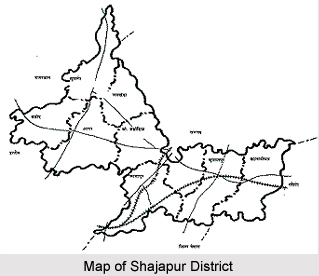 Shajapur district in Ujjain division of Madhya Pradesh was brought during 1981 census. The Shajapur District is identified from the Headquarter town Shajapur named after honor of Shah Jahan the Mughal Emperor who halted here in 1640. It is said that the original name was Shahjahanpur District, which subsequently reduces to Shajapur.
Shajapur district in Ujjain division of Madhya Pradesh was brought during 1981 census. The Shajapur District is identified from the Headquarter town Shajapur named after honor of Shah Jahan the Mughal Emperor who halted here in 1640. It is said that the original name was Shahjahanpur District, which subsequently reduces to Shajapur.
History of Shajapur District
Previously Shajapur was known as “Khankarakhediâ€. Shahjahan and his army liked this place very much and consequently when Shahjahan became king he considered the importance of this place for his Southern campaign .In the year 1640 Meer Bigo was appointed here as Koutwal. He with Shri Jagannath Rawal prepared four dwars (gates) in four directions. In centre developed a marketing place.
Consequently, this area was populated gradually and converted into colony. Surrounding this place a wall was also prepared. Then in respect of king Shahjahan it was named as “Shahjahanpur". In Shahajahanpur twelve areas were located named Magriya, Mahupura, Dansi, Muradpura, Vajeerpura, Kamreedpura, Lalpura, Dayra, Megaspore, Golyakhedi, Juganbadi Meerkala. Muradpura was named after Shahjahan`s son Murad and Muradpura and Meerkala were named after Meer Bigo himself. It is said that Chandralekha River (which is now Chiller) was flowing in North direction before but after establishment of huge fort and for its safety it was brought from East as a parikha of the fort. So at the time of Shahjahan (1628-1658) Jama Masjid, so many temples etc. were developed.
However, at the time of Aurangzeb (1656-1707), this area was totally ignored. After downfall of Mughal dynasty, Shahjahanpur was brought in the Scindia state in 1732 and so many administrative changes were performed. The name "Shahjahanpur" was now " Shajapur" in this period only. Tarabai also developed a beautiful palace in the fort. In 1904, it was declared as a district.
Geography of Shajapur District
The Shajapur District is situated in the northwestern part of the state and lies between 32 degree 06 minutes to 24 degree 19 minutes East longitude 75 degree 41 minutes to 77 degree 02 minutes west. The district is bounded by Ujjain in the west, Dewas and Sehore District, in the South, Rajgarh District in the East and Jhalawar district of Rajasthan in the North. It covers the total area of 6196 sq km. It is situated 453 meter high from sea level. The maximum temperature of the district is 45°C and minimum temperature is 32°C. The annual average rainfall is 938.3milimeters.
The entire district lies in the drainage area of the Chambal River, which is a major tributary of the Yamuna River. The Chambal itself flows towards the north beyond the western boundary of the district. Its tributaries flowing in the district are the Parbati River, the Nawaj, the Kali Sindh River, the Lakhundar, the Ahu and the Auand, the Chhoti, Kali Sindh.
Demographics of Shajapur District
In 2011, according to the population census of India, Shajapur district had a population of 1,512,353 of which male and female were 779,900 and 732,453 respectively. Shajapur District population constituted 2.08 percent of total population. The data shows that the density of Shajapur district for 2011 is 244 people per square kilometers.
The average literacy rate of Shajapur in 2011 was 70.17 compared to 70.86 of 2001.The male and female literacy rate were 83.19 and 56.36 respectively.
Culture of Shajapur District
People celebrate the number of festivals in the district. This district famous for the festivals like Kansvadhotsav and Holi, which is celebrates for five days.
Kans Vadotsav has been celebrated here for more than 150 years. This is a drama of religious and historical importance. People celebrate Kans Vadotsav in Shajapur on the occasion of Dashmi night. After Mathura, it is celebrated in Shajapur, Madhya Pradesh. It is said that the history of Kans Vadotsav is related to Govardhannath Temple. First this festival is known by the name of Kans Leela. KansVadotsav is story of strange and proud of Shajapur.
Education of Shajapur District
In Shajapur, there are few schools and colleges are established. The schools of that area are Mahatma Gandhi Convent School, Shajapur and Saraswti Shishu/Vidhya Mandir. For the higher education, the college is BalKrishna Sharma Naveen (BKSN) College, Shajapur. This college is affiliated with Vikram Uviversity, Ujjain. And there is also another college for the higher studies is Dayanand Saraswati Mahavidhalaya,Shajapur
Economy of Shajapur District
Total land for Agriculture in the district is about 446,000 hectares. Soyabeen is the major crop in this district. Main plants production is taken in 396,000 hectares.
Tourism in Shajapur District
The most tourist attractive spots in Shajapur District are the temples of Shajapur District The Railway line is well connected to various cities.Here the Ujjain-Bhopal,Ujjain-Guna,Makshi-Indoreon,the Ujjain-Bhopal,Makshi, Bercha, Akodiya, Shujalpur, Kalapipal are major railway stations. On the railway track Ujjain-Guna, Shajapur is the main railway station. The districts main bus routes are Agra-Mumbai national highway Agar-Kota, Shajapur-Shujalpur, Shajapur-Agra.






